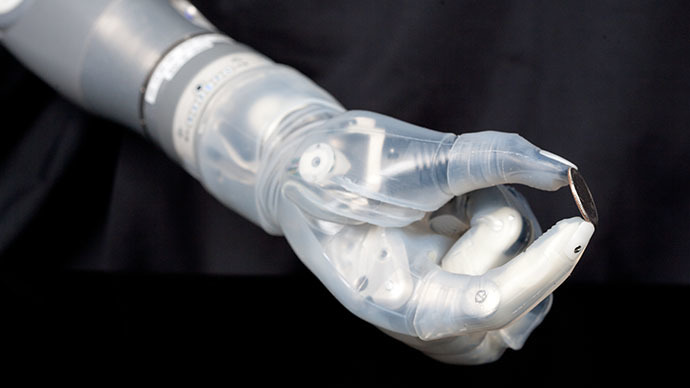Star Wars-style robotic arm approved for mass production

A “near-natural” prosthetic arm, that took eight years to develop and test, has been approved for mass production by the US Food and Drug Administration.
The DEKA Arm System has been affectionately dubbed “The Luke,” after Star Wars’ Luke Skywalker who received a robotic replacement for the hand he lost in a fight with Darth Vader in the 1980 film “The Empire Strikes Back.”
One of the developers, Dean Camen, the inventor of the Segway, says that the new type of a prosthetic limb will dramatically improve the lives of amputees. Tests have shown that subjects fitted with the arm were able to pick up grapes and raisins, use keys and locks, brush hair, open envelopes, pick up an egg without breaking it, eat cereal and even use chopsticks.
According to the recent Food and Drug Administration (FDA) release, it “reviewed clinical information relating to the device, including a 4-site Department of Veterans Affairs study in which 36 DEKA Arm System study participants provided data on how the arm performed in common household and self-care tasks."

The investigation revealed that approximately 90 percent of participants could perform activities with the robotic arm that they were previously unable to undertake, such as “using keys and locks, preparing food, feeding oneself, using zippers, and brushing and combing hair.”
The new artificial arm’s entirely new level of freedom, control and the near natural feel are a far cry from the plastic prosthesis and metal hooks which are currently in use in much of the world, and that have made little functional progress in the last 100 years since the use of wooden limbs, before technological advancement.
“The Luke” can perform multiple, simultaneous powered movements controlled by electrical signals from electromyogram (EMG) electrodes. They convert electrical signals into up to 10 powered movements, detecting electrical activity caused by the contraction of muscles close to where the prosthesis is attached and send signals to a computer processor in the prosthesis that translates them to a specific movement. The DEKA Arm System can be fitted for people with limb loss at the shoulder joint and mid-upper or lower arm, but it can’t be configured at the elbow or wrist joint.
“This innovative prosthesis provides a new option for people with certain kinds of arm amputations and may allow some to perform more complex tasks than they can with current prostheses in a way that more closely resembles the natural motion of the arm,” said Christy Foreman, director of the Office of Device Evaluation at the FDA’s Center for Devices and Radiological Health.
The retail price for the first-of-its-kind, life-altering limb replacement is yet to be set. The search for a suitable manufacturing partner is currently under way.














